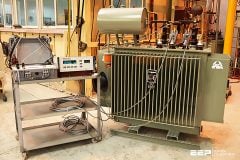https://youtube.com/watch?v=zJ23gmS3KHY%26w%3D624%26h%3D468
Cant see this video? Click here to watch it on Youtube.
Eddy currents are currents induced in conductors to oppose the change in flux that generated them. It is caused when a conductor is exposed to a changing magnetic field due to relative motion of the field source and conductor; or due to variations of the field with time. This can cause a circulating flow of electrons, or a current, within the body of the conductor.
These circulating eddies of current create induced magnetic fields that oppose the change of the original magnetic field due to Lenz’s law, causing repulsive or drag forces between the conductor and the magnet. The stronger the applied magnetic field, or the greater the electrical conductivity of the conductor, or the faster the field that the conductor is exposed to changes, then the greater the currents that are developed and the greater the opposing field.
The term eddy current comes from analogous currents seen in water when dragging an oar breadthwise: localised areas of turbulence known as eddies give rise to persistent vortices.
Eddy currents, like all electric currents, generate heat as well as electromagnetic forces. The heat can be harnessed for induction heating. The electromagnetic forces can be used for levitation, creating movement, or to give a strong braking effect. Eddy currents can often be minimised with thin plates, by lamination of conductors or other details of conductor shape.
RESOURCE: TutorVista- Online Tutor











Is this case concern with when we use single core cable passing through gland plate , the gland plate shpuld be aluminum gland plate , also we use awa armor in single core cable